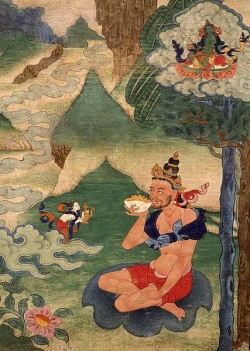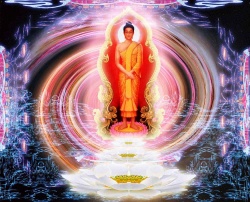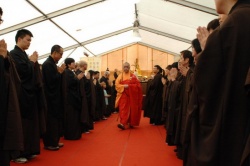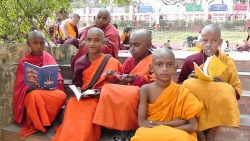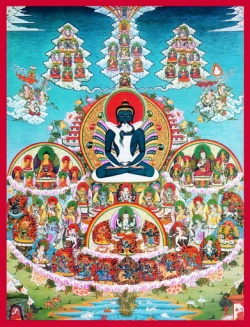Naropa Stories and Teachings
Naropa (Sanskrit: Naropada or Nadapada) (956–1041) was an Indian tantric Buddhist yogi, mystic and monk. He was the disciple of Tilopa. And he was either the brother of Niguma, or partner and pupil of Niguma. Naropa is renowned in Tibetan Buddhism for "the six yogas of Naropa". They are yogic practices. Naropa was the main teacher of Marpa, who founded of the Kagyu school of Tibetan Buddhism.
Naropa was born a Brahmin. When his parents wanted him to marry a young Brahmin girl, he did so. After eight years their marriage was dissolved. At the age of 28 Naropa entered the Buddhist University at Nalanda. There he studied both writ and Tantra. He gained the reputation of a great scholar, engaged in many debates and taught and won many students.
One day while he was studying, a dakini appeared to Naropa and asked if he understood the words of Buddha's teachings. He replied that he did, and what they meant, too. The dakini burst into tears, saying he was a great liar, for the only one who understood the teachings was her brother, Tilopa. Naropa tried to find Tilopa to become fully realised. He abandoned his studies and position at the university and set out. But he had to endure hardships in his quest. However, the hardships wer hidden teachings on his path. When at last he met Tilopa, he was given practices and twelve serious hardships, culminating in realization of Mahamudra (the Great Symbol). Naropa spent twelve years in all with Tilopa.
Later in his life Naropa stayed in Phullahari. There he died aged 85. A Tibetan translator, Ngatso, records from a visit there:
I thought I would go see the Lord Naropa. I had heard that the Lord was staying in the monastery known as Phullahari. Great merit arose from being able to go see him. On the day I arrived, they said some feudal prince had come to pay homage. So I went to the spot, and a great throne had been erected. I sat right in front of it. The whole crowd started buzzing, "The Lord is coming!" I looked and the Lord was physically quite corpulent, with his white hair [stained with henna] bright red, and a vermilion turban on. He was being carried [on a palanquin] by four men, and was chewing betel-leaf. I grabbed his feet and thought, "I should listen to his pronoucements!" Stronger and stronger people, though, pushed me further and further from his feet and finally I was tossed out of the crowd. So, there I saw the Lord's face, but did not actually hear his voice. [Extract]
The scholarly Naropa is remembered as a lineage holder of the Buddhist Kagyu school, and best known for the six yogas of Naropa. They are practices designed to further enlightenment. Many in his lineage were particularly adept at one or more of them, we read. In the Vajrayana tradition they are held to have been given by the Buddha through an unbroken lineage via Tilopa to Naropa, Marpa and Milarepa and on until today.
The Six Yogas of Naropa also called the six dharmas of Naropa. They are a set of advanced tantric practices and a meditation way (sadhana) compiled in and around the time of Naropa (1016-1100 CE) and conveyed to his student Marpa. The six yogas were meant to help in attaining siddhi and enlightenment quicker. Also, the six yogas of Niguma are almost identical to the six yogas of Naropa. The second Dalai Lama, Gendun Gyatso has compiled a work on these yogas.
The "six yogas" are really classified in up to ten yogas.
the yoga of central heat, tummo. This is what many other methods depend on, and is clearly linked to tantric kundalini yoga
the yoga of the "drop-down" body
the yoga of the clear, radiant, subtle, inner light
Practices of the completion stage:
the yoga of the dream state.
the yoga of the intermediate state (as when dying). This is well-known through the Bardo Thödöl.
the yoga of transferring consciousness to a pure Buddhafield.
Sometimes other yogas are grouped with those above, or given as auxiliary practices:
a variation of transferring the consciousness (mindstream) into a recently dead body.
a yoga involving sexual union with a physical partner, either real or visualized. It is based on the yoga of central heat, of which karmamudra is an extension.
the Narada practice of self-liberation
preliminary practices to the central heat yoga.
Tummo (Sanskrit: candali) is a form of yoga, the yoga of body heat. The word tummo literally means fierce [woman], suggesting inner fire. The Sanskrit terms candali and kundalini are etymologically related, and tummo and forms of kundalini yoga are related. The hard core of tummo is to see into things, see better, and for oneself - thus, tummo is for going into one's deep-going mind also. Handy practice is claimed to produce body heat and a blissful sensation.
Teachers of kundalini/tummo practices agree that a student should be well prepared to cope with the powerful energy of the kundalini awakening. The psychotherapist Tara Springett (1960-) writes: "After my initial awakening it was not long before I started to harvest the enormous blessings of this extraordinary event . . ." Further: "The Tibetan Buddhist meditation of 'tummo' . . . is the Tibetan Buddhist equivalent of a kundalini awakening practice." (2014:Intro, passim.)
In Tibetan yoga, the work on tummo, "inner fire", it is the foundation of spiritual realisations and can bring bliss, wisdom and achievement prowess, the Six Yogas of Naropa inform.
So the terms tummo and kundalini deal with a power within. Kundalini in one's ordinarely wakefulness is likened to a serpent that ordinarily rests in a coil in the perineum area - something like that. If well stirred, that coiled life energy straightens up and "lifts its head and body" upwards along the spine, and transmutes the awareness a little or much, depending on how elevated the lifting-up becomes. It can be inwardly felt as a kind of electric energy. Fitly and well stirred life energy can take one to higher levels and thus facilitates various mind levels and even full enlightenment. [Cf. e.g. Woodroofe 1974; Pandit 1972).
How to stir the serpent to get an elevated mind and outlook? Milarepa advocates mantrayana, that is, using well-chosen mantra-repetions aptly for it. There is a special way of breathing that may assist the finely formed stirring too. [More]
Tummo is generally described within the context of Buddhist tantric systems and most widely taught in the Kagyu lineages. Now, tummo training and kundalini yoga are much the same, although applied in not exactly similar ways. The kundalini, or inward serpent power, is the subtle flow that generates body heat. Numerous traditions speak of kundalini, "a dormant power" that may be made to ascend toward real consciousness, or 'higher' awareness states.
For tummo the 'energy winds' (prana) are accumulated to control some subtle body processes for entering within through "refining-and-enforcing" for it. Various "refinement yogas" are for internalising the mind soundly and well and get divine: Dzogchen or Mahamudra systems may not use exactly that word, but see if how far it fits.
Kurt Keutzer (2002) goes into Kundalini yoga, Vajrayana and Milarepa:
Mahasiddhas [great adepts]. . . were active in India from the 8th century to the 12th century. Kundalini yoga practices formed the core of the teachings of a number of these Mahasiddhas and are strongly represented in both Tibetan Buddhist practices and contemporary kundalini yoga practices. . . . Candali yoga was a key practice of the famous Tibetan yogin Milarepa.
That tummo practice was taught by Gautama Buddha and passed down orally until the time of Naropa: that is the faith of many Tibetan Buddhists. At any rate, the mind heat it brings, may increase savoury wisdom, make life far more enjoyable, and give birth to better, higher awareness in the garden of bliss. That is a part of the teaching.
Cf. Wikipedia, s.v. "tummo"
The teachings of Narada's gurudev, Tilopa (988-1069 CE), are the earliest known work on the six yogas. Naropa learned the techniques from him. Naropa's Tibetan student Marpa taught Milarepa. Milarepa in turn taught Rechungpa and Gampopa.
Dalai Lamas are thought to be experts in the six yogas of Naropa.
Before engaging in the actual yogas, there are "six exercises of Naropa" to go on from. "Vase breathing is the first of those six, and pulling the fingers gently and massaging the two hands is the last of them. [Source: Wikipedia, s.v. "Naropa", "Six Yogas of Naropa"]
The next page is about Marpa, who took Naropa's lineage into Tibet, along with many Buddhist insider teachings.
Contents
Naropa stories and teachings, Literature
Musés, C. A., ed, Esoteric Teachings of the Tibetan Tantra. Indiana Hills, CO: The Falcon's Wing Press, 1961 (and other, later editions). Online here: buddhist-tantra.html
Evans-Wentz, Walter Yeeling, ed. The Tibetan Book of the Great Liberation or the Method of Realizing Nirvana through Knowing the Mind. London: Oxford University Press, 1968. - Also on-line.
Evans-Wentz, Walter Yeeling, ed. Tibetan Yoga and Secret Doctrines. 2nd ed. London: Oxford University Press, 1967.
Evans-Wentz, Walter Yeeling, ed. The Tibetan Book of the Dead: After-Death Experiences on the Bardo Plane, according to Lama Kazi Dawa-Samdup's English Rendering. London: Oxford University Press, 1927.
Evans-Wentz, Walter Yeeling, ed. Tibet's Great Yogi Milarepa. Heruka, Tsang Nyön. The Life of Marpa the Translator. Reprint ed. London: Shambala, 1995.
Springett, Tara. Enlightenment Through the Path of Kundalini: A Guide to a Positive Spiritual Awakening and Overcoming Kundalini Syndrome. North Charleston, SC: CreateSpace, 2014.
von Guenther, Herbert, tr. The Life and Teaching of Naropa. London: Shambala, 1986.
